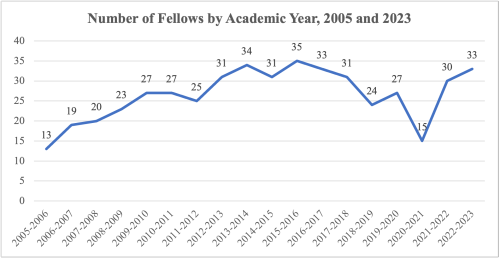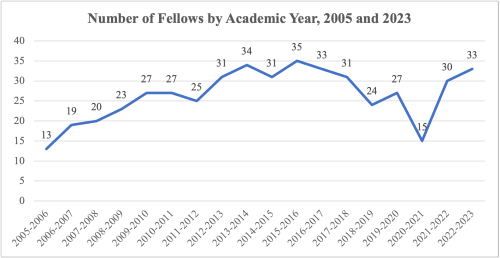
During the ANAMED fellow orientation, the time when most fellows meet each other for the first time, one of the first questions usually is “where are you from?”. The answers are usually very varied: Italy, Spain, Germany, Turkey, the United States, China, etc. I was amazed by the variety of country names and their affiliations that I learned during the orientation, and I also feel very privileged to be part of such an international and intellectual community. As much as I appreciate and love the environment I am working and living in, I am also eager to show such diversity using GIS (Geographic Information Systems), and that is simply because I love GIS and love to observe the patterns revealed on maps.
Firstly, let us look at the summary of the number of fellows over the years. Thus far, there have been 478 fellows since the beginning of the fellowship program. As demonstrated in the chart below, it started with 13 fellows in the 2005–2006 academic year and gradually increased to 35 as the peak in the 2015–2016 academic year. But later the number dropped drastically to 15 (over 57 % decrease) in the 2020–20201 academic year. Probably the pandemic (COVID-19) was the reason for the drop. As we have been slowly moving into the post-pandemic era now, we can see that the number has come back since last year. It is also worth noting that the gradual increase in the first 7 years was followed by steady high years between 2012 and 2017, but the number slightly decreased to 24 in the 2018–2019 academic year. This change may be a chain reaction resulting in part of the terror attacks in Istanbul between 2015 and 2017, especially the one on Istiklal street on March 19, 2016. Nonetheless, I would be curious to inquire what the incentives or measures (if there were any different from other years) were for these high numbers during 2012 and 2017 that ANAMED could bring back some of those strategies.

Chart credit: Xin Hong
Source: ANAMED
Based on the provided data, I chose the country of affiliation and nationality, respectively, as the attributes to represent the diversity of ANAMED fellows. The fellows over the years were affiliated with institutions in 27 different countries, and in terms of nationality, they came from 38 different countries. Below is an interactive web map demonstrating these two attributes[1]. There are three main map layers under the Content tab on the top-left side: 1) Country name, 2) Number of fellows by country of affiliation, and 3) Number of fellows by nationality. The first layer country name is an annotation of the country name. Number of fellows by country of affiliation (the second layer) and Number of fellows by nationality (the third layer) are presented as choropleth maps with the same data classification intervals. Since the data of these two layers are classified with the same intervals, the spatial patterns revealed are comparable to each other. You may check the number of fellows in relation to either country of affiliation or nationality for a specific country by clicking anywhere within that country’s boundary. You may also refer to the Legend tab on the top-left side for the map key (data classification intervals).https://www.arcgis.com/apps/Embed/index.html?webmap=e608ca130f0f43b9b6548f4a6bb2c166&extent=-28.0498,0.6072,155.8174,69.0657&zoom=true&previewImage=false&scale=true&disable_scroll=true&theme=light
Web map link:https://arcg.is/yCbju
Credit: Xin Hong
Source: ANAMED
We may notice that fellows were mainly from institutions in North America, Europe, and Central Asia. As much as we may appreciate the international and diverse background of the fellows, the spatial disparity presented here can be hardly neglected. Surprisingly (to me at least), the United States, Turkey, and the Western European region account for the most participation in the fellowship, and the United States predominately outweighs other countries. The number 165 suggests that since the beginning of the fellowship program, there have been 165 out of 461 fellows[2] coming from institutions in the United States, accounting for 36% of the total number. The second and third countries on the list are Turkey and the United Kingdom, which have the numbers 75 and 63, respectively. In contrast to this predominance, we see a few numbers from Central Asia (5)[3], Japan (2), and Argentina (1). There is also inescapable emptiness in Africa, the majority of Asia, the Pacific region, and the majority of South America.
In terms of the number of fellows by nationality, not surprisingly, accordingly to the aforementioned patterns in affiliation, Turkey, the United States, and West Europe are the regions that have the largest number. But comparably, fellows’ nationality seems to be more spatially spread out than affiliation. Fellows were from more different countries in Asia (e.g., China, Malaysia, and Afghanistan) and South America (Mexico and Colombia) despite the numbers from these regions being still minimal. It is also interesting to see that there is a switch of order between the United States and Turkey in the country of affiliation and nationality. On one hand, the United States has the exceptionally largest number in terms of affiliation (165), while it is not the top country in terms of nationality (96). On the other hand, Turkey has less than half the number of the United States by country of affiliation (75), but it outweighs the United States by nationality (133). An assumption that drawn from such contrast would be, even though most fellows are from Turkey in terms of nationality, it does not mean that being Turkish is likely to be selected as fellows but having education or being affiliated with the United States does.
There is no doubt that the rich history of Anatolia attracts scholars from all over the world to gather in ANAMED to research Anatolian civilizations. As a geographer, who is foreign to the research domains related to Anatolian civilizations, I specifically attend to the spatial patterns disclosed on maps. Through checking the spatial disparities of the country of affiliation and nationality of ANAMED fellows, respectively, I have some questions and reflections:
1. We may see that fellows are predominantly from institutions in the United States, Turkey, and Europe. We may also see that there are remarked, big blanks in Asia, Africa, and the Pacific region. Does it mean that there are no institutions or strong programs studying Anatolian civilizations in these regions? If the answer is yes, then why is that? By now, we may already have some bold thoughts rising on our unspoken minds. Or at least some assumptions that this may be related to differences in power and economy.
2. We may say that because of historical reasons, the United States and Europe already have well-established and long-standing programs and institutions researching Anatolian civilizations. Quite “naturally”, applicants from institutions in these countries are more likely to be selected as fellows because of their competency. In the long term, it is likely, or it already is, that knowledge of Anatolian civilizations and their derivative economic and political values are always owned and controlled by certain groups of people, as opportunities are always limited in the opposite groups. All these may be facts now, but it does not necessarily mean that they have to stay this way in the future.
Further steps for improving this web map would be adding a chart of yearly changes as a pop-up window for each country. By doing this we may see how the numbers of fellows from different affiliations and with different nationalities, respectively, changed over time for a specific country. Fellowship types (e.g., Ph.D., post-doctoral, and senior) and their research outcomes (e.g., presentations and publications) by country could also be mapped to further understand the outcomes of the fellowship program. In addition, the nationality information of new fellows in the 2022–2023 academic year could be added in the future when the data is available. This may provide a more up-to-date and comprehensive presentation of the diversity.
As a Turkish saying goes, iğneyi kendine çuvaldızı başkasına batır (prick the small needle on yourself first then the big one for others), because I love ANAMED and that is why I criticize it and would like to see it continue thriving with diversity.
—————————————————————————————————————–
[1] The total number of Uzbekistan, Kazakhstan, and Tajikistan
[2] There were 17 fellows who were independent scholars (no affiliations), so they were not included in the mapping of the country of affiliation. Fellows from the 2022–2023 academic year were not included in the mapping of nationality, because the nationality information was not available at the time of the work.
[3] Excluding 17 independent scholars.

